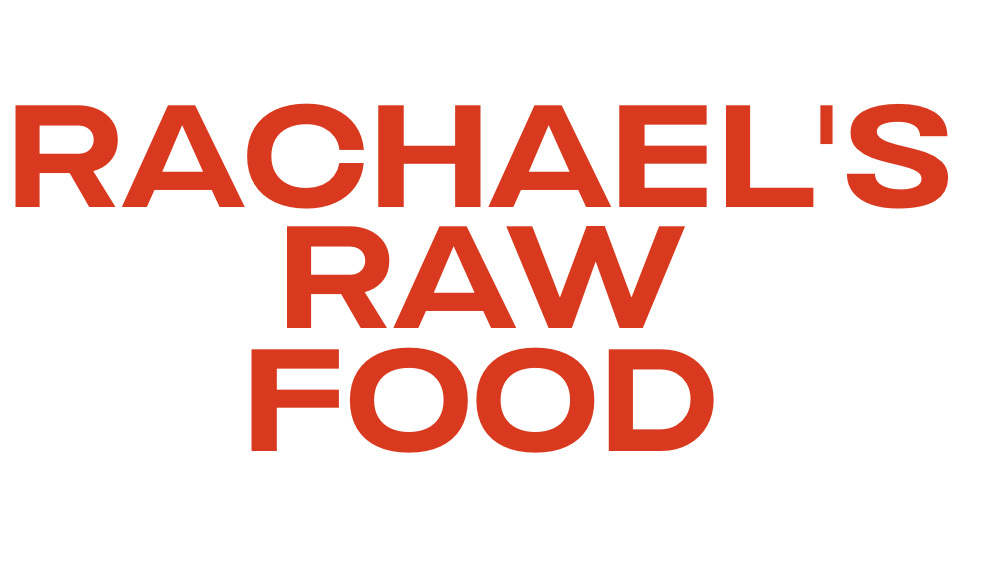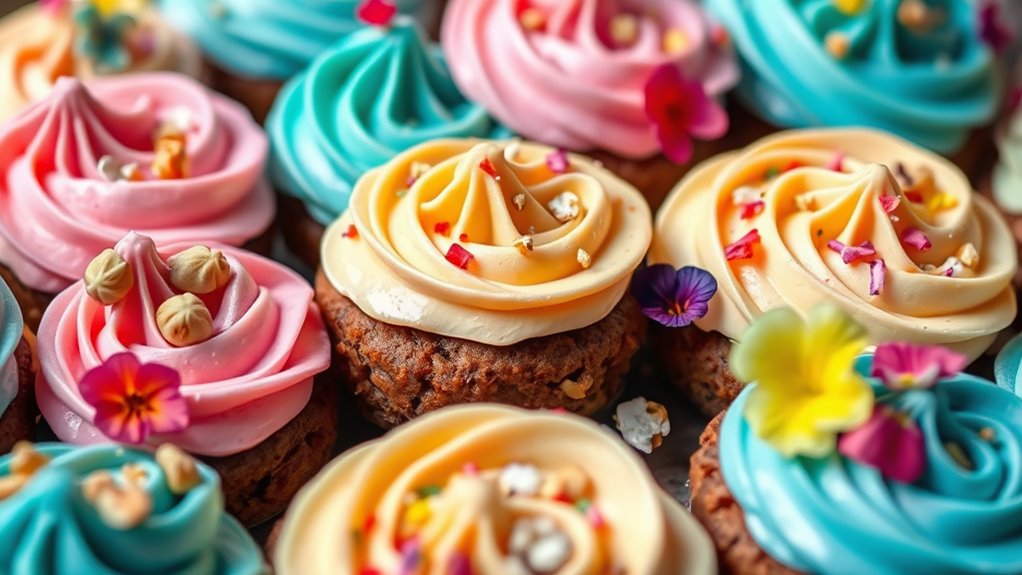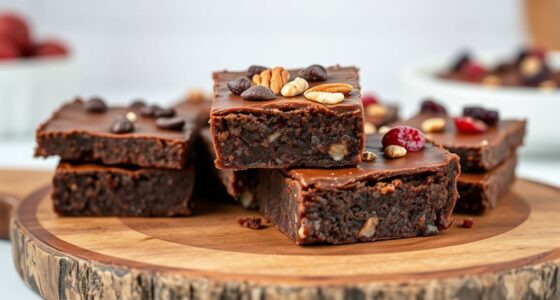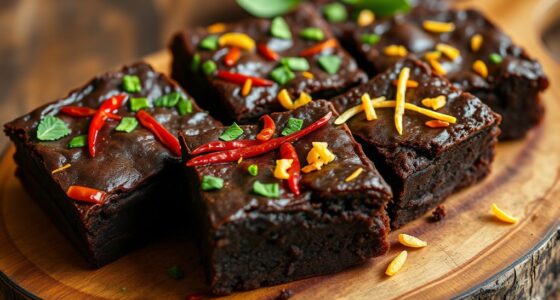To decorate raw cookies and brownies, start by using vibrant frostings like cream cheese, chocolate ganache, or flavored buttercreams to add color and flavor. Top with a variety of toppings such as sprinkles, edible glitter, crushed nuts, or fresh fruit for texture and visual appeal. Incorporate fondant shapes or piped details for intricate designs, and consider layering flavors for an eye-catching finish. If you keep exploring, you’ll discover even more tips to elevate your dessert decor.
Key Takeaways
- Use natural, unprocessed ingredients like cashew or coconut-based frostings for a raw, vegan-friendly finish.
- Top cookies and brownies with fresh fruit, nuts, or seeds for added texture and visual appeal.
- Incorporate raw chocolate drizzles or ganache made from raw cacao for rich flavor and decorative effect.
- Add edible flowers or herbal sprigs as natural, decorative toppings that enhance the raw aesthetic.
- Use raw, dehydrated toppings like coconut flakes or cacao nibs to create contrasting textures and visual interest.
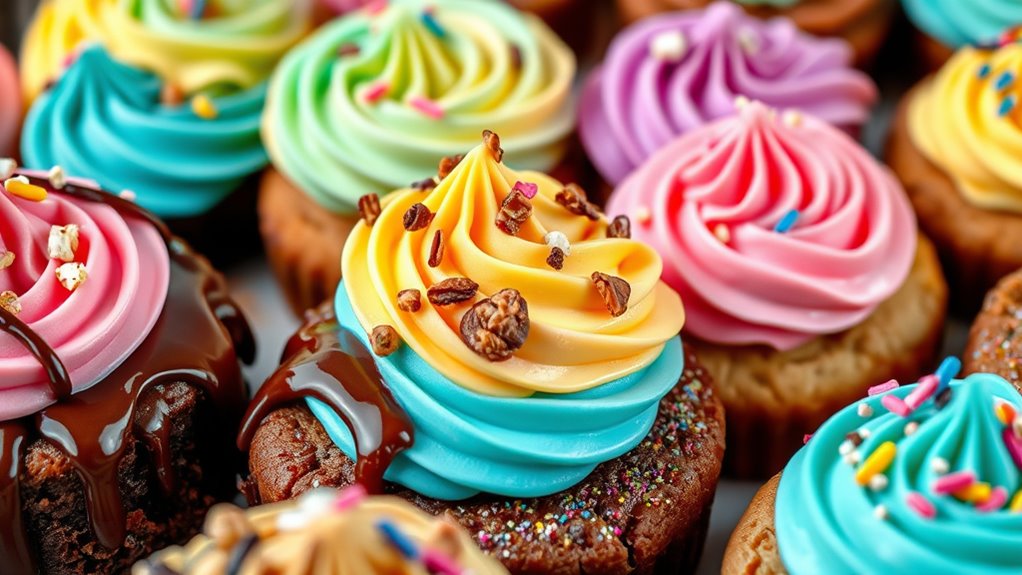
Decorating cookies and brownies offers a fun and creative way to elevate your desserts and impress guests. When it comes to adding intricate details or a polished look, fondant techniques are your best friend. Using fondant allows you to craft smooth, professional-looking decorations that can be shaped into flowers, figures, or detailed patterns. To start, roll out your fondant to a uniform thickness and use cookie cutters or templates to cut out shapes. You can place these directly onto your baked goods for a clean, elegant finish. For more elaborate designs, you might mold fondant into 3D shapes or layered decorations, giving your treats a bakery-quality appearance. Applying fondant isn’t just about aesthetics; it also provides a sturdy surface for additional embellishments, like edible glitter.
Speaking of embellishments, edible glitter adds a touch of sparkle that can truly make your decorations pop. After applying fondant shapes or other toppings, sprinkle a fine layer of edible glitter over the surface. This creates a shimmering effect that’s perfect for special occasions or just to add some extra flair. To avoid clumping, lightly dust the glitter over your decorations or use a clean brush to apply it precisely where you want the shimmer. Edible glitter is versatile—use it to highlight certain areas, outline shapes, or create a sparkling background. When combined with fondant techniques, edible glitter transforms simple cookies and brownies into eye-catching desserts that look as fantastic as they taste.
In addition to fondant and glitter, don’t underestimate the power of a well-executed piping technique. Using piping bags fitted with fine tips allows you to add delicate details, borders, or lettering. These small touches can tie together your overall design and add a professional finish. For a more layered approach, you can incorporate contrasting colors or textures—such as a drizzle of chocolate over fondant or a sprinkle of crushed nuts on frosting—to bring depth and complexity to your desserts.
Frequently Asked Questions
Are Raw Frostings Safe to Eat Without Baking?
You might wonder if raw frosting safety is a concern when eating without baking. Generally, raw topping ingredients like cream cheese, butter, and powdered sugar are safe, but raw eggs or dairy can pose risks. Always check recipes for raw eggs or unpasteurized ingredients. If you’re unsure, opt for recipes with heat-treated ingredients or use pasteurized products to enjoy raw frostings safely.
How Long Do Raw Dessert Toppings Typically Last?
Like a delicate flower, raw dessert toppings need proper care to stay fresh. Typically, their shelf life ranges from a few days to a week when stored in an airtight container in the refrigerator. Follow storage guidelines to prevent spoilage, especially if they contain perishable ingredients. Always check for signs of spoilage before use, and for longer storage, consider freezing them to extend freshness.
Can Raw Frosting Be Stored at Room Temperature?
You can store raw frosting at room temperature for a short period, usually up to two days, but it’s best to refrigerate it for longer storage to preserve flavor variations and prevent spoilage. Room temperature storage may affect its texture and freshness over time. If you’re planning to keep it longer, refrigeration helps maintain the frosting’s quality and safety, ensuring it stays delicious and suitable for your baked treats.
What Are Natural Alternatives for Colored Toppings?
Think of natural alternatives for colored toppings as a painter’s palette of vibrant, plant-based hues. You can use natural food dyes or plant-based colorants like beet juice for red, turmeric for yellow, or spirulina for green. These options are like a garden bursting with color, offering a healthier, eco-friendly way to decorate your treats without artificial dyes. You’ll love how beautifully these natural options enhance your desserts.
Do Raw Toppings Affect the Texture of Cookies and Brownies?
Raw topping variations can influence the texture of your cookies and brownies, but the impact is usually minimal. They add flavor and visual appeal without drastically changing the structure. You might notice slight differences depending on the ingredients used, which can affect moisture levels or crunchiness. Overall, raw toppings typically enhance your dessert without compromising the desired texture, making them a versatile choice for creative decorating.
Conclusion
Think of your dessert decorations as tiny works of art that reflect your creativity and passion. Each frosting swirl and topping symbolizes your personal touch, turning simple cookies and brownies into memories and moments of joy. Like a delicate ornament on a tree, your decor adds beauty and meaning, reminding you that even the smallest details can make life sweeter. Embrace your artistry—your decorated treats become symbols of love, effort, and the sweet rewards of sharing.
